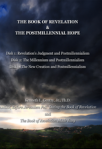THE NEW CREATION IN CHRIST
PMW 2023-080 by Geerhardus Vos

Gentry note:
As noted in my last posting, a new version of several of Geerhardus Vos’ works on eschatology will soon be published. This book collects together some of his important eschatological articles and updates them in the process — removing his awkward, cumbersome, early-20th century writing style. In this particular excerpt from the updated Vos, he deals with the concept of a new creation in Christ.
Vos observations:
The recognition of the eschatological source of the term “new ktisis” has been held back by its assumed individual use in 2 Corinthians 5:17: “Wherefore if any man is in Christ, he is a new creature.” And likewise by the exclusively subjective-soteriological reference the representation seemed to suggest. Both obstacles also make themselves felt in regard to Titus 3:5. But in regard to neither of the two passages can these objections obscure the quite perceptible eschatology texture.
The context clearly shows that Paul in Corinthians means something far more specific than the metaphorical statement about someone’s having been made “a new man” would ordinarily convey. For the one who has undergone this experience of having become “in Christ,” not merely individual subjective conditions have been changed. Rather “the old things are passed away, new things have come into being.” There has been created a totally new environment. Or, more accurately speaking, there has been created a totally new world in which the person spoken of is an inhabitant and participator.
It is not in the first place the interiority of the subject that has undergone the change, although that, of course, is not to be excluded. The whole surrounding world has assumed a new aspect and complexion. That the efficient cause for the thing described lies “in Christ” clearly indicates that such is the fact. Christ nowhere with the Apostle figures merely as a productive center of new individuals: He is everywhere, where the formula in question occurs, the central dominating factor of a new order of affairs. He is in fact nothing less than the originator and representative of a new world-order.
A mere glance at the Pauline (and generally NT) usage of ktisis will further bear out the comprehensive and objective associations of the word (cp. Rom. 8:19–20; Col. 1:15; Heb. 9:11; Rev. 3:14). Nor does the context permit any restriction to the renovated inner nature of the Christian subjectively considered. The whole argument of the passage revolves around the substitution of one objective status and environment for another. It belongs to the chapter on “justification” equally much as to that on inward renewal. 2 Corinthians 5:18 speaks of “all things” as “being of God,” which again is not naturally understood of the subjective internal condition of the believer alone. Also the term katallassesthai (“to reconcile”) points to the objective sphere. And in its Greek import, as distinct from the English Bible rendering, is quite flexible and broad enough to allow of this widening out of the concept to the idea of a “change” affecting the whole world.

The Book of Revelation and Postmillennialism (Lectures by Ken Gentry)
In the first of these three 50-minute lectures Gentry explains Revelation’s judgments to show they do not contradict postmillennialism. In the next two lectures he shows how the Millennium and the New Creation themes strongly support the gospel victory hope found in postmillennialism.
See more study materials at: www.KennethGentry.com
In view of all this there is ample reason for favoring the rendering “a new creation.” And this, when once substituted, directly points to the eschatological antecedents of the idea and opens up the perspective of its other-worldly far-reaching significance. Hence the Apostle speaks in 2 Corinthians 5:18 of all things, indicating that not a single point but a comprehensive range of renewal stands before his mind. The whole antithesis spoken of is for him determined by the complexion of the Christ who stands in the center of it. To know of, that is to reckon with, a Christ kata sarka (“according to [the] flesh”) means one constitution of things. To reckon with a differently complexioned Christ, kata pneuma (“according to [the] Spirit”), though not explicitly named, means a different, an opposite constitution of things. And in this case can only be the eschatological one. How the reference to justification, lying on the surface of the argument, can fit into this eschatologically-colored interpretation will appear presently.
Not so strongly reminiscent of eschatological origins is the phrase kaine ktisis in the second instance of its occurrence: “For neither is circumcision anything nor uncircumcision, but a new creation” (Gal. 6:16). Still even here the thought of the new final order of affairs with new values of enduring equalizing character is by no means absent.
On the negative side it clearly finds expression in the immediately preceding avowal: “Far be it from me to glory, save in the cross of our Lord Jesus Christ, through whom (or which) the world has been crucified unto me and I unto the world.” The cross is here represented as effecting an absolute separation between two worlds. And this cuts loose the Apostle from the world to which he at first belonged, and having transplanted him into another. This separation was so radical that the two parts between whom it took place were afterwards equally unable to have community of interests one with the other. For the world was no less crucified to Paul than Paul was to the world.

Four Views on the Book of Revelation (ed. by Marvin Pate)
Helpful presentation of four approaches to Revelation. Ken Gentry writes the chapter on the preterist approach to Revelation, which provides a 50 page survey of Revelation .
See more study materials at: www.KennethGentry.com
At first it naturally seems difficult to fit in this conception of the effect of the cross with the usual modes of teaching developed concerning the same in other contexts of the Epistles. The difficulty disappears if we call to mind the Christologico-eschatological background of the statement. It is first of all with reference to Christ and the kosmos that such a sharp divorce has taken place through the cross. The cross, that is to say his death under the peculiar circumstances in which it took place, cut through the bond which for a definite period of time had tied Him to the kosmos. It threw Him out from the world, and He departed from it to enter another world, which was his real home.
It needs no pointing out that in Christ’s case this exchange of one world for another possessed before anything else eschatological features and proportions. It made Him not so much a “new creature,” as the veritable beginner of a “new creation.” Now, in conscious assimilation of his own experience to this train of thought, the Apostle affirms of himself that he is crucified to the world, as the world is to him. And further that henceforth in his new sphere of existence, a new creation is the decisive, all-important factor. Thus, it will hardly do justice to Paul’s intent to confine it to the idea of endowment with a new and higher nature or personality. The conception is too weighty for that.
The fundamental underlying idea must be that of an incorporation into a new system of reality, a fact which renders it in principle eschatological. How the Apostle would have expressed himself without conscious side-reference to the objective eschatological situation can be seen from Galatians 5:6: “For in Christ Jesus neither circumcision avails anything nor uncircumcision, but faith working through love.” Here, it will be observed, where the thought is subjectively turned, the opposite to circumcision and uncircumcision is not “a new creation,” but “faith working through love.”
It is not different with the term palingenesia occurring in Titus 3:5: “not by works of righteousness which we have done, but according to his mercy he saved us, by the washing of regeneration, and renewing of the Holy Spirit.” To be sure, here the indigenous soteriological meaning seems to be strongly attested through the combination with loutron, “the washing” of palingenesia (“regeneration”) and of anakainsis (“renewing”), which are both “of the Holy Spirit.” Baptism to our consciousness certainly is something pertaining to the present Christian state. Nevertheless, the very fact of its being joined to palingenesia proves that it must have in its conception a definite bearing on the future life. Within the New Testament this is indicated by 1 Peter 3:21, where the world-overwhelming flood appears as its type, has ascribed to it a power saving from the antitypical judgment: “The like figure whereunto even baptism doth also now save us (not the putting away of the filth of the flesh, but the answer of a good conscience toward God) by the resurrection of Jesus Christ.”
In extra-biblical sources already the eschatological meaning appears in evidence. And it is not as a derived metaphorical usage. On the contrary, the philosophico-mythological is the prior meaning, and an occasional figurative use is felt as having been derived from that. Of individual eschatology it is used in connection with the Dionysiac myth in referring to which Plutarch speaks of the apobiseis (“death”) and the pallingenesthai (“rebirth”). In the Pythagorean doctrine of the transmigration of souls the term was used technically as the opposite of the prote genesis (“first birth”) or nun genesis (“now birth”). With Philo it signifies the life after death, individually conceived, but also is applied to the future world collectively. Subsequently, however, the metaphorical meaning developed, even in Philo. Cicero calls his return from banishment his palingenesia. Eschatological likewise is the single occurrence in the Septuagint of Job 14:14, which reads: “All the days of my warfare would I wait es palin genmai [‘until I exist again’].”

The Harrowing of Hell (by Jay Rogers)
This postmillennial book examines the power of the Gospel, not only to overcome all opposition, but to rise far above the powers of hell. The term “Harrowing of Hell” refers to idea that Christ descended into Hell, as stated in the Apostles’ Creed.
For more Christian educational materials: www.KennethGentry.com
Besides by pagan authorities, the eschatological sense is attested by the saying of our Lord in the New Testament itself. For in Matthew 19:28 he says: “Ye who have followed me shall in the regeneration, when the Son-of-Man shall sit on the throne of his glory, also sit upon twelve thrones, judging the twelve tribes of Israel.” In this saying the word cannot be restricted to the more or less individualizing application of the resurrection. It covers the resurrection as a whole and even the renewal of the universe. For this is shown from the parallels in Mark and Luke, which have as its equivalent descriptions of the final state (Mark 10:29–30; Luke 22:29–30). Thus also Josephus understands the term, making it interchangeable with apokatastasis (“restoration”).
Under these circumstances the eschatological reference in connection with baptism in Titus 3:5 can create no surprise. It made itself so naturally felt that Origen on Matthew 19:28 declares baptism to be the prooimion (“prelude”) to that palingenesia (i.e., the great palingenesia of the resurrection). Even Clement of Rome still says that Noah preached a palingenesia to the kosmos. The familiar soteriological sense appears first with Clement of Alexandria.
Kenneth L. Gentry Jr.'s Blog
- Kenneth L. Gentry Jr.'s profile
- 85 followers



